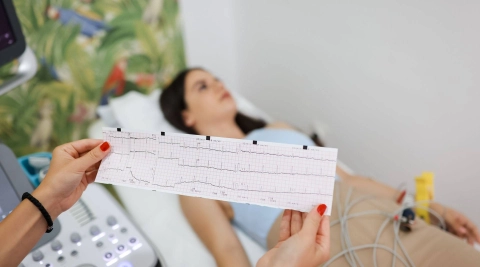Conditions Angina (angina pectoris)
ICD codes: I20 What are ICD codes?
Angina, also known as angina pectoris or stenocardia, refers to sudden pain in the heart area (cardiac region) during physical exertion or stress, for example. A common cause of this pain is the narrowing of one or more arteries in the heart. As a result, some of the heart muscle receives an inadequate supply of blood and oxygen.
At a glance
- Angina is usually caused by coronary heart disease.
- With this condition, arteries in the heart are often narrowed, producing pain in the chest.
- A surgical procedure may be necessary, depending on the severity of the symptoms.
Note: The information in this article cannot and should not replace a medical consultation and must not be used for self-diagnosis or treatment.

What is angina?
The Latin term “angina pectoris” means “tight chest”. Angina pectoris, often referred to simply as angina, may develop if one or more cardiac arteries become narrowed due to vascular calcification (arteriosclerosis).
It can be triggered by physical exertion or stress, for example. The heart muscle no longer receives an adequate supply of blood and oxygen, resulting in sudden pain in the heart area.
Important: Chest pain may also indicate a heart attack. In this case, immediate medical assistance is essential. If in doubt, always dial 112 (the German emergency number) and request an ambulance – not the medical on-call or stand-by GP service (“Ärztlicher Notdienst” or “Ärztlicher Bereitschaftsdienst”).
What are the symptoms of angina?
Angina has various symptoms. There may be mild chest pains only, for example when climbing the stairs. However, it can also lead to sudden, severe pain in the cardiac region. These may radiate outwards into the left arm, lower jaw, upper abdomen, or back.
In most cases, these pains only last during the period of exertion, and fade after a few minutes. With advanced heart disease, the pain may also last for longer or commence even when at rest.
What causes angina?
Angina is often the first tangible indication of coronary heart disease. It is a consequence of arteriosclerosis, also known as “vascular calcification”. This starts with minor inflammation and damage on and in artery walls, where immune cells, fats and other substances accumulate. Such deposits are known as arteriosclerotic plaques. If they form in the blood vessels that supply the cardiac muscle (i.e. the cardiac arteries), narrow sections form that hinder the blood flow.
In most cases, this only becomes evident when the heart needs increased blood and oxygen – for example, during physical exertion. This is why the pains and feelings of tightness in the chest subside when the body is at rest. This condition is referred to as “stable angina”.
If the chest pain occurs while a person is at rest, i.e. without any prior stress, this is referred to as “unstable angina”. In such cases, constriction of the blood vessels is extremely advanced and the person is at risk of an acute heart attack. This occurs if a cardiac artery is completely blocked.
A heart attack must be instantly treated to prevent part of the heart muscle from dying.
What are the risk factors for angina?
The key risk factors for angina are:
The risk of disease increases with age.
Video Why is high blood pressure dangerous?
The video below explains what happens in the body in the event of high blood pressure. What consequences can high blood pressure have and how can it be lowered?
This and other videos can also be found on YouTube
Watch nowThe privacy policy indicated there applies.
How does angina progress?
Doctors use a grading system for angina, with four classes to indicate varying degrees of severity:
- Level 1: chest pain during sudden mental or physical strain but not during everyday activities like walking or climbing the stairs
- Level 2: chest pain during heavy exertion, such as running at speed, walking uphill and walking upstairs after meals – also in conjunction with cold or mental stress
- Level 3: chest pain during light physical exertion, such as regular walking or getting dressed
- Level 4: chest pain while at rest or during tasks involving minimal physical exertion
Important: The severity of the angina partly depends on the blood supply to the cardiac muscle. As a general rule, someone suffering from angina is also more likely to suffer a heart attack or other consequences of coronary heart disease.
What can be done to prevent angina?
Anything that can be done to maintain a healthy cardiovascular system is also a suitable means of preventing this condition:
It has yet to be established whether vitamins and dietary supplements help prevent heart disease.
More information on what people can do to promote a healthy heart can be found at gesundheitsinformation.de.
How is angina diagnosed?
Chest pain can have many causes, including problems with the muscle and bones in this area.
The main method used to detect angina is an electrocardiogram (ECG), which records the electrical signals in the heart. This can be performed at rest or under strain.
Cardiac imaging is also sometimes used, for example in the form of an ultrasound (echocardiography). Additional investigations may sometimes also be required. The determining factors are age, the type of symptoms involved, and the presence or absence of additional diseases.
Angina occurs as a result of coronary heart disease. To assess the risk of other health conditions and precisely plan treatment, the doctor performs a number of other tests such as:
- blood pressure measurement
- thorough physical examination
- test for metabolic disorders (e.g., type 2 diabetes)
- identification of further risk factors
What screening options are available?
People with statutory health insurance are entitled to a one-off health check-up between the age of 18 and 35 and the same check-up every three years from the age of 35. The primary aims of screening include providing indications of cardiovascular diseases, diabetes and kidney diseases. The check includes a blood and urine test and a measurement of blood pressure.
How can angina be treated?
With stable angina, medication, such as beta blockers, calcium channel blockers, and nitrates, can relieve everyday symptoms and improve quality of life.
If treatment with these medications is insufficient, a procedure can be attempted to widen the constricted coronary artery using a cardiac catheter.
A bypass operation is possible if an artery is significantly constricted or if several arteries are affected. In this surgical procedure, an artery is taken from elsewhere in the body and used to “divert” blood around the blocked artery.
Treating angina can also help prevent the development of complications such as a heart attack or cardiac insufficiency – for example, by ensuring a healthy diet and sufficient exercise. Smokers are advised to quit.
Several forms of medication can also help prevent complications and increase life expectancy. These particularly include antiplatelet medication for preventing blood clots and statins for protecting the blood vessels.
More detailed information about treating angina can be found at gesundheitsinformation.de.
- Anderson JL, Morrow DA. Acute Myocardial Infarction. N Engl J Med. 2017 May 25;376(21):2053-2064. doi: 10.1056/NEJMra1606915.
- Baigent C, Blackwell L, Collins R et al. Aspirin in the primary and secondary prevention of vascular disease: collaborative meta-analysis of individual participant data from randomised trials. Lancet. 2009 May 30;373(9678):1849-60. doi: 10.1016/S0140-6736(09)60503-1.
- Bundesärztekammer (BÄK). Nationale VersorgungsLeitlinie Chronische KHK. S3-Leitlinie. AWMF-Registernummer nvl – 004. 09.2022.
- Cholesterol Treatment Trialists’ (CTT) Collaboration; Baigent C, Blackwell L, Emberson J et al. Efficacy and safety of more intensive lowering of LDL cholesterol: a meta-analysis of data from 170,000 participants in 26 randomised trials. Lancet. 2010 Nov 13;376(9753):1670-81. doi: 10.1016/S0140-6736(10)61350-5.
- Cholesterol Treatment Trialists' (CTT) Collaboration; Fulcher J, O'Connell R, Voysey M, Emberson J et al. Efficacy and safety of LDL-lowering therapy among men and women: meta-analysis of individual data from 174,000 participants in 27 randomised trials. Lancet. 2015 Apr 11;385(9976):1397-405. doi: 10.1016/S0140-6736(14)61368-4.
- Ko DT, Hebert PR, Coffey CS, Sedrakyan A, Curtis JP, Krumholz HM. Beta-blocker therapy and symptoms of depression, fatigue, and sexual dysfunction. JAMA. 2002 Jul 17;288(3):351-7. doi: 10.1001/jama.288.3.351.
- Marshall IJ, Wolfe CD, McKevitt C. Lay perspectives on hypertension and drug adherence: systematic review of qualitative research. BMJ. 2012 Jul 9;345:e3953. doi: 10.1136/bmj.e3953.
- Mills EJ, Wu P, Chong G, Ghement I, Singh S, Akl EA, Eyawo O, Guyatt G, Berwanger O, Briel M. Efficacy and safety of statin treatment for cardiovascular disease: a network meta-analysis of 170,255 patients from 76 randomized trials. QJM. 2011 Feb;104(2):109-24. doi: 10.1093/qjmed/hcq165.
- Vandvik PO, Lincoff AM, Gore JM, Gutterman DD, Sonnenberg FA, Alonso-Coello P, Akl EA, Lansberg MG, Guyatt GH, Spencer FA. Primary and secondary prevention of cardiovascular disease: Antithrombotic Therapy and Prevention of Thrombosis, 9th ed: American College of Chest Physicians Evidence-Based Clinical Practice Guidelines. Chest. 2012 Feb;141(2 Suppl):e637S-e668S. doi: 10.1378/chest.11-2306.
In cooperation with the Institute for Quality and Efficiency in Health Care (Institut für Qualität und Wirtschaftlichkeit im Gesundheitswesen – IQWiG).
As at:





